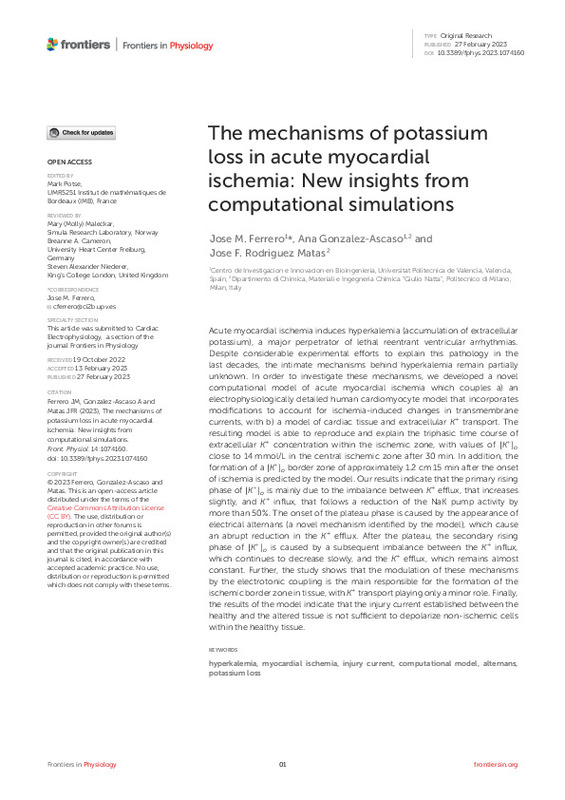JavaScript is disabled for your browser. Some features of this site may not work without it.
Buscar en RiuNet
Listar
Mi cuenta
Estadísticas
Ayuda RiuNet
Admin. UPV
The mechanisms of potassium loss in acute myocardial ischemia: New insights from computational simulations
Mostrar el registro sencillo del ítem
Ficheros en el ítem
| dc.contributor.author | Ferrero De Loma-Osorio, José María
|
es_ES |
| dc.contributor.author | González-Ascaso, Ana
|
es_ES |
| dc.contributor.author | Rodriguez Matas, Jose F.
|
es_ES |
| dc.date.accessioned | 2024-02-01T19:01:03Z | |
| dc.date.available | 2024-02-01T19:01:03Z | |
| dc.date.issued | 2023-02-27 | es_ES |
| dc.identifier.issn | 1664-042X | es_ES |
| dc.identifier.uri | http://hdl.handle.net/10251/202295 | |
| dc.description.abstract | [EN] Acute myocardial ischemia induces hyperkalemia (accumulation of extracellular potassium), a major perpetrator of lethal reentrant ventricular arrhythmias. Despite considerable experimental efforts to explain this pathology in the last decades, the intimate mechanisms behind hyperkalemia remain partially unknown. In order to investigate these mechanisms, we developed a novel computational model of acute myocardial ischemia which couples a) an electrophysiologically detailed human cardiomyocyte model that incorporates modifications to account for ischemia-induced changes in transmembrane currents, with b) a model of cardiac tissue and extracellular K (+) transport. The resulting model is able to reproduce and explain the triphasic time course of extracellular K (+) concentration within the ischemic zone, with values of [ K + ] o close to 14 mmol/L in the central ischemic zone after 30 min. In addition, the formation of a [ K + ] o border zone of approximately 1.2 cm 15 min after the onset of ischemia is predicted by the model. Our results indicate that the primary rising phase of [ K + ] o is mainly due to the imbalance between K (+) efflux, that increases slightly, and K (+) influx, that follows a reduction of the NaK pump activity by more than 50%. The onset of the plateau phase is caused by the appearance of electrical alternans (a novel mechanism identified by the model), which cause an abrupt reduction in the K (+) efflux. After the plateau, the secondary rising phase of [ K + ] o is caused by a subsequent imbalance between the K (+) influx, which continues to decrease slowly, and the K (+) efflux, which remains almost constant. Further, the study shows that the modulation of these mechanisms by the electrotonic coupling is the main responsible for the formation of the ischemic border zone in tissue, with K (+) transport playing only a minor role. Finally, the results of the model indicate that the injury current established between the healthy and the altered tissue is not sufficient to depolarize non-ischemic cells within the healthy tissue. | es_ES |
| dc.description.sponsorship | This work was supported by the "Programa Salvador de Madariaga 2018" of the Spanish Ministry of Science, Innovation and Universities (Grant Reference PRX18/00489), by Grant PID 2019-104356RB-C41 funded by the Spanish Ministry of Science and Innovation, and Italian Ministry of Education, University and Research, Grant number 1613 FISR2019_03221, CECOMES. | es_ES |
| dc.language | Inglés | es_ES |
| dc.publisher | Frontiers Media SA | es_ES |
| dc.relation.ispartof | Frontiers in Physiology | es_ES |
| dc.rights | Reconocimiento (by) | es_ES |
| dc.subject | Hyperkalemia | es_ES |
| dc.subject | Myocardial ischemia | es_ES |
| dc.subject | Injury current | es_ES |
| dc.subject | Computational model | es_ES |
| dc.subject | Alternans | es_ES |
| dc.subject | Potassium loss | es_ES |
| dc.subject.classification | TECNOLOGIA ELECTRONICA | es_ES |
| dc.title | The mechanisms of potassium loss in acute myocardial ischemia: New insights from computational simulations | es_ES |
| dc.type | Artículo | es_ES |
| dc.identifier.doi | 10.3389/fphys.2023.1074160 | es_ES |
| dc.relation.projectID | info:eu-repo/grantAgreement/AEI/Plan Estatal de Investigación Científica y Técnica y de Innovación 2017-2020/PID2019-104356RB-C41/ES/MODELO MULTIESCALA DE PATOLOGIAS CARDIACAS Y OPTIMIZACION DE TERAPIAS PERSONALIZADAS/ | es_ES |
| dc.relation.projectID | info:eu-repo/grantAgreement/MCIU//PRX18%2F00489/ | es_ES |
| dc.relation.projectID | info:eu-repo/grantAgreement/MIUR//1613 FISR2019_03221/ | es_ES |
| dc.rights.accessRights | Abierto | es_ES |
| dc.contributor.affiliation | Universitat Politècnica de València. Escuela Técnica Superior de Ingenieros Industriales - Escola Tècnica Superior d'Enginyers Industrials | es_ES |
| dc.description.bibliographicCitation | Ferrero De Loma-Osorio, JM.; González-Ascaso, A.; Rodriguez Matas, JF. (2023). The mechanisms of potassium loss in acute myocardial ischemia: New insights from computational simulations. Frontiers in Physiology. 14:1-24. https://doi.org/10.3389/fphys.2023.1074160 | es_ES |
| dc.description.accrualMethod | S | es_ES |
| dc.relation.publisherversion | http://doi.org/10.3389/fphys.2023.1074160 | es_ES |
| dc.description.upvformatpinicio | 1 | es_ES |
| dc.description.upvformatpfin | 24 | es_ES |
| dc.type.version | info:eu-repo/semantics/publishedVersion | es_ES |
| dc.description.volume | 14 | es_ES |
| dc.identifier.pmid | 36923288 | es_ES |
| dc.identifier.pmcid | PMC10009276 | es_ES |
| dc.relation.pasarela | S\508117 | es_ES |
| dc.contributor.funder | AGENCIA ESTATAL DE INVESTIGACION | es_ES |
| dc.contributor.funder | Ministerio de Ciencia, Innovación y Universidades | es_ES |
| dc.contributor.funder | Ministero dell'Istruzione, dell'Università e della Ricerca | es_ES |
| dc.subject.ods | 03.- Garantizar una vida saludable y promover el bienestar para todos y todas en todas las edades | es_ES |








